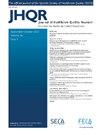A retrospective cohort study of onco-hematologic inpatients with SACT at the end of life in a single cancer institution: Differences between solid tumors and hematological neoplasms
IF 1
Q4 HEALTH CARE SCIENCES & SERVICES
引用次数: 0
Abstract
Background
This study compares mortality indicators in patients with solid tumors (ST) and hematological neoplasms (HN) who died in the hospital during systemic anticancer therapy (SACT) in the last 30 days of life. We used indicators described by Earle: SACT < 30d, SACT < 14d, therapeutic regimen changes, and palliative care referrals. We also analyzed the impact of palliative care availability on patient survival.
Methods
Between 2017 and 2022, we identified, validated, and registered 2285 cases through our institution's Mortality Subcommittee (MS) that met the inclusion criteria for this cohort.
Results
We observed differences in indicators between ST and HN consistent with published literature. These differences occurred both in therapeutic intensity (higher in HN) and in palliative care referrals (higher percentage for ST). When analyzing survival from advanced disease definition to death, no statistically significant differences emerged between patients with HN versus ST, or between those with and without palliative care.
Conclusions
The published differences between subgroups (ST vs HN) persist even in our hospital death cohort, confirming the need for pathology-specific standards.
一项回顾性队列研究,在单一癌症机构对SACT晚期肿瘤-血液学住院患者:实体瘤和血液学肿瘤之间的差异
本研究比较了生命最后30天在医院接受全身抗癌治疗(SACT)期间死亡的实体瘤(ST)和血液肿瘤(HN)患者的死亡率指标。我们使用Earle描述的指标:SACT <; 30d, SACT < 14d,治疗方案改变和姑息治疗转诊。我们还分析了姑息治疗对患者生存的影响。方法:在2017年至2022年期间,我们通过我们机构的死亡率小组委员会(MS)确定、验证并登记了2285例符合该队列纳入标准的病例。结果我们观察到ST和HN在指标上的差异与已发表的文献一致。这些差异发生在治疗强度(HN较高)和姑息治疗转诊(ST较高百分比)。当分析从晚期疾病定义到死亡的生存率时,HN和ST患者之间,或接受和不接受姑息治疗的患者之间没有统计学上的显著差异。结论已发表的亚组(ST与HN)之间的差异即使在我们的医院死亡队列中也存在,这证实了对病理特异性标准的需求。
本文章由计算机程序翻译,如有差异,请以英文原文为准。
求助全文
约1分钟内获得全文
求助全文
来源期刊

Journal of Healthcare Quality Research
Medicine-Health Policy
CiteScore
1.70
自引率
8.30%
发文量
83
审稿时长
57 days
期刊介绍:
Revista de Calidad Asistencial (Quality Healthcare) (RCA) is the official Journal of the Spanish Society of Quality Healthcare (Sociedad Española de Calidad Asistencial) (SECA) and is a tool for the dissemination of knowledge and reflection for the quality management of health services in Primary Care, as well as in Hospitals. It publishes articles associated with any aspect of research in the field of public health and health administration, including health education, epidemiology, medical statistics, health information, health economics, quality management, and health policies. The Journal publishes 6 issues, exclusively in electronic format. The Journal publishes, in Spanish, Original works, Special and Review Articles, as well as other sections. Articles are subjected to a rigorous, double blind, review process (peer review)
 求助内容:
求助内容: 应助结果提醒方式:
应助结果提醒方式:


